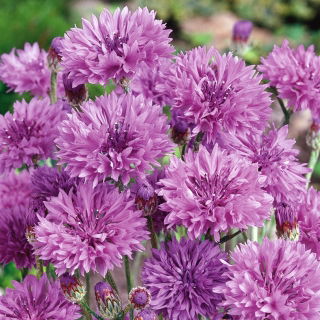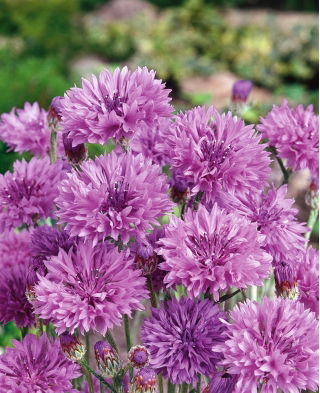Cornflower, known scientifically as Centaurea cyanus, is an exceptional annual plant that will undoubtedly add charm to any garden. Its full, violet blooms attract bees and other beneficial insects, making it an ideal choice for those wishing to support biodiversity in their surroundings. Reaching a height of 50 to 80 cm, the cornflower forms upright stems and grey-green leaves, which blend beautifully with other plants in flower beds and wildflower meadows. It is also recommended as a cut flower, allowing you to enjoy its beauty indoors.
Sowing
Cornflower is best sown directly into the ground, allowing it to develop naturally and adapt to environmental conditions. This method enables the seeds to fully benefit from the soil and climate, resulting in healthy growth and abundant flowering.
Sowing Depth
Cornflower seeds should be placed at a depth of 0.5 to 1.5 cm. This depth provides the seeds with optimal conditions for germination, protecting them from drying out and excessive soil pressure.
Direct Sowing Period
When to sow cornflower seeds directly into the ground? The best time for sowing is from March to May. Choosing this period ensures the plants have suitable moisture and temperature conditions, promoting uniform emergence and vigorous development.
Plant Spacing
Cornflower requires appropriate spacing of 15x30 cm. This distance between plants allows for unrestricted growth and ensures adequate air circulation, minimising the risk of fungal diseases.
Companion Planting
Cornflower pairs well with other ornamental plants such as poppies, marigolds, and cosmos. This allows for the creation of diverse floral compositions that catch the eye and form a harmonious ensemble.
Site Conditions
Cornflower thrives in sunny locations, where it can fully benefit from sunlight. The soil should be well-drained and moderately fertile to provide optimal growth conditions. It's also important that the soil is well-drained to prevent waterlogging and potential root rot.
Growing Tips
Cornflower does not require complex care, making it an ideal choice for novice gardeners. It's advisable to regularly remove faded flowers, stimulating the plant to continue blooming. Additionally, during dry periods, remember to water regularly to ensure the plant has optimal moisture conditions.
Plant Height
The cornflower reaches a height of 50 to 80 cm, making it an excellent choice for creating layered floral arrangements. Its upright stems add elegance and structure to the garden.
Flowering Period
Cornflower blooms from June to September, providing a long-lasting garden decoration. Its full, violet flowers attract attention and create a beautiful backdrop for other plants.
Usage
Cornflower is suitable for flower beds, wildflower meadows, and as a cut flower. Its intense colour and delicate flower structure make it a popular choice for bouquets and floral arrangements.
Resistance to Diseases
Cornflower is resistant to most diseases, making it easy to grow. This means it doesn't require intensive chemical protection, which is beneficial for both the environment and the gardener.
Good to Know
Cornflower is a symbol of natural beauty and simplicity, attracting not only insects but also birds and small mammals that benefit from its nectar and seeds. This plant is also known for its medicinal properties and is used in herbal medicine.
Why Buy from Garden Seeds Market
Purchasing cornflower seeds from Garden Seeds Market guarantees top quality and reliability. The seeds come from responsible cultivation and have undergone rigorous quality testing. The store offers fast delivery and competitive prices, allowing you to enjoy your garden's beauty without unnecessary delays. Satisfied customer reviews confirm that choosing seeds from Garden Seeds Market is an investment in a healthy and beautiful garden.
The packet contains 0.6 g of seeds. The packaging includes information on cultivation guidelines and the sow-by date.






